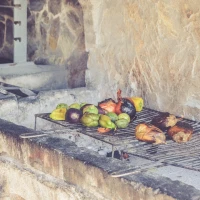There’s nothing quite like enjoying a succulent pork tenderloin dish, especially when the flavors are locked in just right and the texture is perfect. But what do you do when you have leftovers and crave that same mouthwatering experience the next day? Reheating pork tenderloin holds the potential challenge of turning this beautifully tender meat into an overcooked, dry disappointment. This comprehensive guide will address the art of reheating your pork tenderloin so that its flavors and juices are as delectable as when it first came out of the oven. Master the technique, and you’ll say goodbye to the days of less-than-impressive leftovers.
Whether you’re seeking a quick lunch fix or planning for an elegant dinner with saved time, our step-by-step guide will lead you to the ultimate leftover satisfaction. Follow these strategies for reheating pork tenderloin and ensure your meat remains juicy, tasty, and tender.
Understanding the Basics of Reheating Pork
Reheating any cooked meat without compromising its texture and flavor requires a basic understanding of the cooking process and what makes pork tenderloin stand out in the culinary world.
What Makes Pork Tenderloin Special?
Pork tenderloin is known for its tenderness and lean texture, which come from the fact that it’s a muscle that does very little work. This cut of meat is also loved for its versatility in dishes, from roasted how to reheat cornbread grilled preparations.
- Quick cooking time: Due to its size and tenderness, pork tenderloin cooks much quicker than denser pork cuts.
- Minimal fat content: The lean nature of pork tenderloin means less fat, which also means you need to pay extra attention to prevent it from drying out during reheating.
Key Reheating Considerations
- Retain moisture: It’s crucial to reheat in a way that doesn’t sap the natural juices from the meat.
- Uniform heat distribution: Ensure the heat penetrates evenly to avoid unevenly warmed leftovers.
- Safety: Pork should be reheated to the safe temperature of 165°F to ensure it’s safe to eat.
Preparing Your Pork Tenderloin for Reheating
Before you start the reheating process, proper preparation is key to maintaining the quality of your leftover pork chop milanese tenderloin.
Repackaging for Moisture Retention
- Wrap tightly with foil to lock in moisture and to prevent the tenderloin from drying out.
- Use a bit of broth or water: Adding a liquid element can help to reinvigorate the meat and keep it moist.
- Bring to room temperature: Leaving the pork on the counter for 10-15 minutes before reheating can help ensure more even warming.
Reheating Techniques That Work
Different methods can be used for reheating pork tenderloin, each affecting the outcome in terms of texture and flavor.
Reheating in the Oven
The most reliable method for reheating pork tenderloin is in the oven. Here’s how you can achieve the best results:
- Preheat your oven to 325°F to allow for gentle warming.
- Place the pork tenderloin in an oven-safe dish and add a splash of stock or water.
- Cover the dish with aluminum foil to trap the moisture and heat.
- Reheat for approximately 25-30 minutes, or until the pork reaches an internal temperature of 165°F.
- Employ a meat thermometer to gain precise control over the reheating process.
Using the Microwave
For those who are pressed for time, the microwave can be a significant time-saver:
- Slice the pork tenderloin into even pieces to ensure even reheating.
- Lay the pieces out flat in a microwave-safe container.
- Cover with a damp paper towel to help retain moisture.
- Microwave on medium power in 30-second bursts, checking the temperature regularly until it reaches the safe temperature of 165°F.
On the Stovetop
Reheating on the stovetop is an excellent way to preserve the original sear of the pork tenderloin:
- Slice the pork into medallions to maximize surface area for heating.
- Preheat a skillet over medium heat with a bit of oil to prevent sticking.
- Place the slices in the skillet and cook for 1-2 minutes per side, or until they reach the needed internal temperature.
The Role of Vegetables in Reinvigorating Pork Tenderloin
Vegetables are not just accompaniments to your dish; they can play a key role in enhancing the reheating process itself.
Creating a Flavorful Bed of Vegetables
- Use a bed of roasted vegetables as a flavorful platform on which to reheat your pork tenderloin in the oven.
- The vegetables will absorb the juices that run off the pork, creating a delicious and cohesive side dish.
Steaming With Aromatic Vegetables
- Steam the pork tenderloin with a selection of aromatic vegetables like onions, carrots, or celery.
- These aromatics can infuse the meat with additional flavors, as well as produce a moist environment for gentle reheating.
Pairing Pork Tenderloin With the Right Vegetables
The choice of vegetables to accompany your reheated pork tenderloin can elevate the final taste of your meal to new heights.
Flavor Pairing Recommendations
- Root vegetables, like carrots and potatoes, with their earthy sweetness, complement the savoriness of pork.
- Leafy greens, such as spinach or kale, offer a fresh, mild bitterness which contrasts nicely with the rich pork.
- Bell peppers and onions can add a crunch and zest to the dish, balancing the soft texture of the reheated tenderloin.
How to Store Leftover Pork Tenderloin
Proper storage is paramount to preserving the quality of your leftover pork tenderloin.
Cool Quickly
- Always cool your cooked pork tenderloin quickly to minimize bacterial growth.
- Cut it into smaller pieces to cool faster and store evenly.
Airtight Storage Solutions
- Wrap the pork tightly in plastic wrap or aluminum foil, or place it in an airtight container.
- The less air in contact with the pork, the lower the chance of it drying out or absorbing unwanted flavors.
Creative Ways to Use Reheated Pork Tenderloin
Don’t just settle for a simple reheated plate of pork — get creative with your leftovers.
Transform Into New Dishes
- Shred the tenderloin to use in tacos, burritos, or as a protein boost for salads.
- Incorporate into a stir-fry with a medley of vegetables for a quick and healthy dinner option.
Pair with Fresh Sauces
- Revitalize your pork tenderloin with a homemade chimichurri or a zesty vinaigrette.
- A robust BBQ sauce or tangy mustard dressing can bring new life to your leftovers.
Mistakes to Avoid When Reheating Pork Tenderloin
To preserve the quality of your reheated pork tenderloin, avoid these common pitfalls:
Overheating
- Monitor the temperature closely: Overcooking your pork tenderloin can quickly lead to a dry and tough texture.
- Reheat slowly and at a low temperature: This allows for a thorough warming that won’t overdo it.
Skipping the Rest Time
- Allow the reheated pork tenderloin to rest briefly before serving. This helps redistribute the juices throughout the meat.
Neglecting the Use of Liquids
- Forgetting to add a splash of broth, water, or even wine can miss an opportunity to maintain or add moisture during the reheating process.
Wrapping Up: The Secrets to Succulent Reheated Pork Tenderloin
Reheating pork tenderloin is an art that, when mastered, can transform your leftovers into a meal that rivals the original. By understanding how to preserve the meat’s tenderness, employing the right reheating techniques, and pairing your pork with flavorful vegetables and sauces, you unlock the full potential of your leftover pork tenderloin.
In conclusion, remember to reheat slowly, utilize moisture-retaining methods, and always consider the creative culinary potential of your tenderloin. With these tips and tricks, you’re now equipped to reheat pork tenderloin to its finest, ensuring that each bite remains as juicy and flavorful as it was freshly cooked. Say goodbye to the pitfalls of reheating and embrace the artistry of reviving your pork tenderloin leftovers to their full glory.










